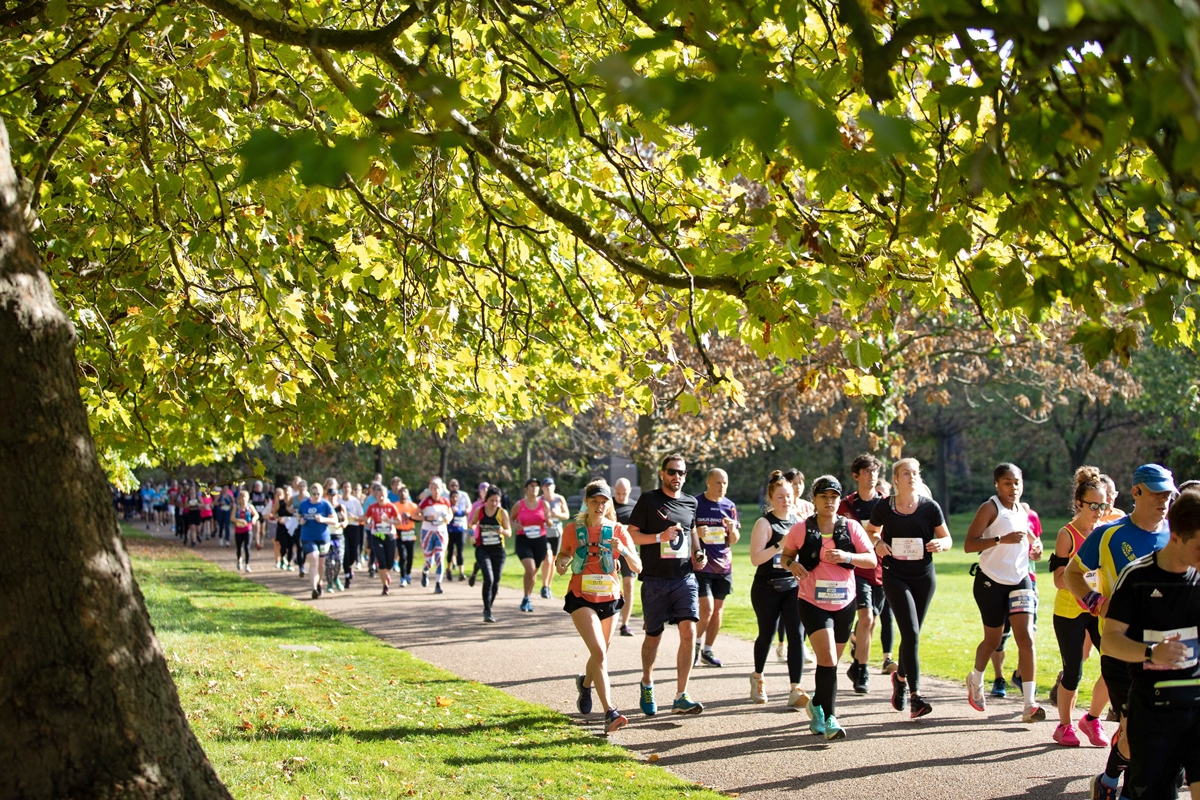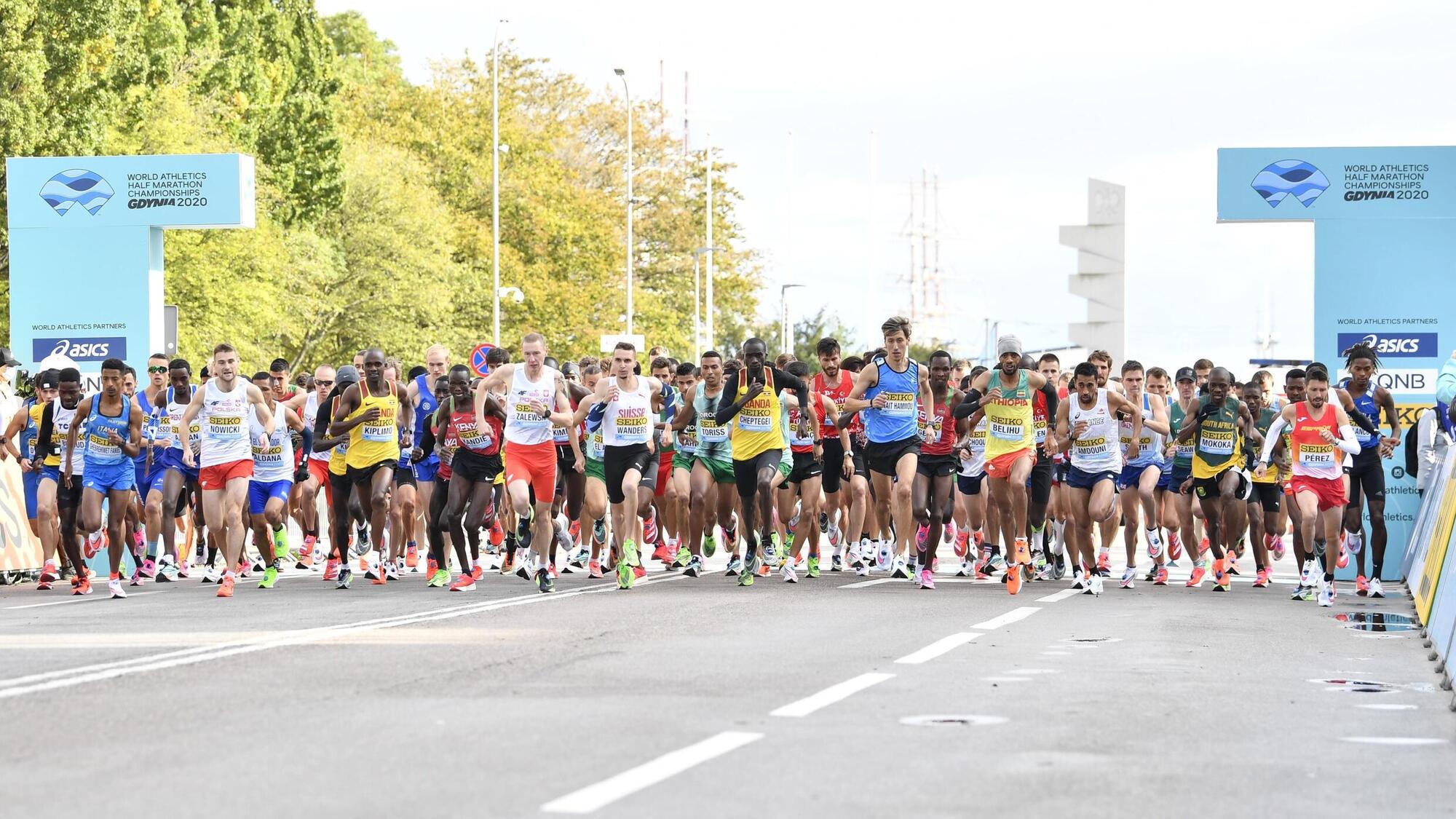

Featured
Calculate: How Long To Run Half Marathon
Modified: January 1, 2024
Calculate how long it takes to run a half marathon with our featured tool. Get an estimate of your finish time and track your progress.
Introduction
Running a half marathon is a challenging yet rewarding achievement. Whether you’re a seasoned runner or just starting your fitness journey, training for a half marathon requires dedication, time, and proper planning. One of the key aspects of your training is determining how long it will take to prepare for the race.
There are several factors to consider when estimating your half marathon training time. Your current fitness level, running experience, and overall health will play a significant role in how quickly you can prepare for the race. Additionally, the training plan you follow and your commitment to consistent training will greatly impact your progress.
The average training time for a half marathon typically ranges from 8 to 12 weeks, depending on your fitness level and the desired intensity of your training. However, it’s important to remember that every individual is different, and your personal training time may vary.
There are various half marathon training plans available, each with its own timeline and approach. Some plans focus on gradually increasing mileage, while others incorporate speed work and interval training. It’s essential to choose a plan that aligns with your fitness goals and abilities.
To calculate your personal half marathon training time, you’ll need to assess your starting point and set realistic goals. This involves evaluating your current running ability and determining how much time you can devote to training each week. By considering these factors, you can create a customized training plan tailored to your needs.
It’s worth noting that several factors may affect your half marathon training time. Factors such as age, weight, previous injuries, and overall health can impact your progress. It’s important to listen to your body, make necessary adjustments to your training plan, and consult a healthcare professional if needed.
In this article, we’ll explore the factors to consider in half marathon training, the average training time, different training plans, and how to calculate your personal training time. We’ll also discuss the factors that may affect your training time and provide some useful tips for meeting your half marathon training goal.
Factors to Consider in Half Marathon Training
When embarking on your half marathon training journey, there are several factors to consider that will impact your progress and overall success. By understanding these factors and incorporating them into your training plan, you’ll be better equipped to achieve your goals. Let’s explore some of the key factors:
1. Fitness Level: Your current fitness level is a crucial factor in determining your training time. If you’re already an active individual who regularly engages in cardiovascular activities, you may have a head start. However, if you’re relatively new to running or have been sedentary, it will take more time to build the necessary endurance and strength.
2. Running Experience: Previous running experience can also influence your training time. If you have a solid running foundation or have completed shorter distance races, you may need less time to prepare for a half marathon. On the other hand, if you’re new to running, it’s essential to gradually increase your mileage to prevent injuries and allow your body to adapt.
3. Lifestyle Commitments: Your daily schedule and lifestyle commitments play a significant role in your training time. Consider factors such as work, family, and other obligations when planning your training schedule. Be realistic about the time you can commit to training each week to avoid burnout and allow for proper recovery.
4. Training Plan: The training plan you choose will have a direct impact on your training time. There are various plans available, ranging from beginner-friendly to advanced. Each plan has a unique structure and focuses on different aspects of training, such as distance, speed, or endurance. Select a plan that aligns with your goals, abilities, and time available for training.
5. Injury History: Previous injuries can affect both the duration and intensity of your training. If you’ve had recurring injuries or ongoing issues, it’s essential to address these before diving into a half marathon training program. Consult a healthcare professional or a running coach to create a plan that takes your injury history into account and includes proper injury prevention techniques.
6. Nutrition and Rest: Proper nutrition and rest are critical components of successful half marathon training. Your diet should provide adequate fuel for your training and promote recovery. Likewise, sufficient rest and sleep allow your body to recover and adapt to the demands of training. Neglecting these aspects can lead to fatigue, decreased performance, and increased risk of injury.
By considering these factors and implementing them into your training plan, you can set realistic expectations and increase your chances of achieving your half marathon goal. Remember, every individual is unique, and what works for one person may not work for another. Listen to your body, make adjustments when needed, and prioritize both physical and mental well-being throughout your training journey.
Average Training Time for Half Marathon
When training for a half marathon, it’s important to have a realistic understanding of the average training time involved. While individual training times may vary based on factors such as fitness level and experience, a general guideline can provide a starting point for your training plan.
The average training time for a half marathon typically ranges from 8 to 12 weeks. This timeline allows for a gradual increase in mileage and intensity, ensuring that your body has enough time to adapt and prevent burnout or injuries.
For beginners who are starting from scratch or have little running experience, it is advisable to allocate at least 12 weeks for training. This extended timeframe allows for a slower progression, as you gradually build up both your endurance and distance capabilities.
On the other hand, more experienced runners who are already comfortable with longer distances may choose a shorter training period of 8 to 10 weeks. This condensed timeframe assumes a higher starting fitness level and focuses more on fine-tuning your performance and race strategy.
Ultimately, the goal is not simply to complete the half marathon but to do so in a way that minimizes the risk of injury and maximizes personal satisfaction. Rushing through training or pushing yourself too hard can lead to overtraining and potential setbacks.
It’s worth noting that while the average training time provides a general guideline, there is flexibility for individual adjustments. Some runners may require additional time to build up their fitness level, while others may be able to progress faster. It’s important to listen to your body and adjust your training plan accordingly.
In addition to the overall training time, it’s essential to consider the frequency and duration of your training sessions. Aim for at least three to four runs per week, gradually increasing the mileage as you progress. Incorporating cross-training and rest days into your plan will also play a crucial role in your overall training progress.
Remember that everyone is unique, and what works for one person may not work for another. It is important to personalize your training plan to suit your specific needs and goals. Consulting with a running coach or following a reputable training program can provide valuable guidance and ensure that you’re on the right track.
By dedicating the appropriate amount of time to your half marathon training, you give yourself the best chance of success. Consistency, patience, and a gradual approach will help you build the necessary endurance and strength to conquer the distance and cross that half marathon finish line with confidence.
Different Training Plans for Half Marathon
When it comes to training for a half marathon, there are various training plans available to suit different fitness levels, goals, and schedules. These plans provide a structured approach to gradually increase mileage, improve endurance, and prepare you for race day. Let’s explore some popular training plans:
1. Novice Training Plan: This plan is designed for beginners who are new to running or have limited experience with longer distances. It typically spans 12-16 weeks and focuses on gradual progression and building a solid foundation. The plan incorporates a combination of running, rest days, and cross-training activities to prevent burnout and reduce the risk of injury.
2. Intermediate Training Plan: For runners who have completed a few races and aim to improve their performance, an intermediate training plan is ideal. This plan typically lasts 10-12 weeks and includes a mix of shorter runs, interval training, tempo runs, and long runs. It also incorporates cross-training activities to enhance overall fitness and prevent monotony.
3. Advanced Training Plan: The advanced plan is suitable for seasoned runners who already have a strong running base and want to target specific race goals or achieve personal records. It involves a higher weekly mileage, speed work, hill training, and race-specific workouts. This plan typically lasts 8-10 weeks and requires a higher level of commitment and discipline.
4. Hal Higdon’s Training Plans: Developed by renowned running coach Hal Higdon, these plans cater to various fitness levels, including novice, intermediate, and advanced. They offer detailed day-by-day training schedules, incorporating a mixture of easy runs, long runs, cross-training, and rest days. Higdon’s plans are popular for their flexibility and guidance, allowing customization to fit individual needs.
5. Jeff Galloway’s Run-Walk Method: This unique approach, developed by Olympian Jeff Galloway, combines running and walking to increase endurance and reduce the risk of injury. The method involves alternating between short intervals of running and walking during the training runs and the race itself. It is particularly beneficial for beginners or individuals recovering from injuries.
It’s important to choose a training plan that aligns with your fitness level, goals, and lifestyle. Consider factors such as the time commitment, your preference for rest and cross-training, and any personal limitations or considerations. Additionally, don’t be afraid to modify the plan as needed to accommodate your schedule or to address any unforeseen circumstances.
Remember that the training plan is a guide, and it’s crucial to listen to your body throughout the process. Pay attention to any signs of fatigue, adjust your pace or mileage if necessary, and prioritize rest and recovery. Consulting with a running coach or seeking guidance from experienced runners can also provide valuable insights and support.
By following a structured training plan that suits your needs, you’ll gradually build the necessary endurance, strength, and confidence to conquer the half marathon distance. Remember to stay consistent, embrace the journey, and enjoy the process of preparing for and completing your race.
Calculating Your Personal Half Marathon Training Time
Calculating your personal half marathon training time involves assessing your starting point, setting realistic goals, and creating a customized training plan tailored to your needs. The following steps will guide you in determining an appropriate training timeline:
1. Evaluate Your Current Fitness Level: Take an honest assessment of your current fitness level and running ability. Consider factors such as your regular running distance, pace, and level of endurance. This self-evaluation will help you establish a baseline and understand how much time you need to prepare for a half marathon.
2. Set Realistic Goals: Determine your goals for the half marathon, whether it’s simply finishing the race or achieving a specific time target. Having a clear goal in mind will help you design a training plan that aligns with your objectives.
3. Determine Training Frequency: Decide how many days a week you can commit to training. Aim for at least three to four running sessions per week to build consistency and gradually increase your mileage.
4. Allocate Time for Long Runs: Long runs play a crucial role in half marathon training. Determine how much time you can dedicate each week for these lengthier sessions. Start with a comfortable distance and gradually increase it over time.
5. Factor in Recovery Days: Rest and recovery days are just as important as training days. Plan for at least one or two days of rest each week to allow your body to recover and minimize the risk of overuse injuries.
6. Consider Your Schedule: Take into account your weekly schedule and any commitments that may impact your training. Be realistic about the time you can allocate to running and ensure it aligns with your other obligations.
7. Start Gradually: Begin your training plan with a lower mileage and gradually increase it week by week. This gradual progression allows your body to adapt and reduces the risk of injury. Listen to your body, and if you experience any discomfort or pain, adjust your training accordingly.
8. Seek Professional Guidance: If you’re unsure about creating a training plan or have specific concerns or limitations, consider consulting with a running coach or experienced runner. They can provide valuable insights, personalized advice, and help you create a training plan that suits your needs.
Remember, the key to calculating your personal half marathon training time is to be realistic and listen to your body. Every individual is different, and what works for one person may not work for another. Be flexible and willing to modify your plan as needed to accommodate changes in your fitness level, schedule, or unforeseen circumstances.
By taking the time to assess your starting point, set goals, and create a tailored training plan, you’ll be well on your way to successfully completing your half marathon with confidence and enjoyment.
Factors That May Affect Your Training Time
While the average training time for a half marathon provides a general guideline, it’s important to recognize that various factors can influence the duration of your training. Consider the following factors that may affect your training time:
1. Previous Running Experience: Your prior running experience can significantly impact your training time. If you have a solid running foundation or have completed races of shorter distances, you may be able to progress more quickly. On the other hand, if you’re new to running or have limited experience, it may take longer to build the necessary endurance and fitness level.
2. Fitness Level: Your current fitness level plays a crucial role in determining your training time. If you are already active and have a good level of cardiovascular fitness, you may require less time to prepare for a half marathon. However, if you’re starting from a relatively lower fitness level, it will likely take more time to develop the endurance and strength needed for the race.
3. Age: Age can also influence your training time. As we age, our bodies may require more time for recovery and adaptation. It’s important to consider this and make any necessary adjustments to your training plan to accommodate your body’s needs.
4. Injury History: Previous injuries can significantly impact your training time. If you’ve had recurring injuries or ongoing issues, it’s crucial to address them before starting your training program. It may require additional time to focus on injury prevention, rehabilitation, and gradually building up strength to avoid re-injury.
5. Time Availability: The amount of time you can dedicate to training each week will affect your training timeline. If you have a busy schedule with limited availability, you may need a longer training period to gradually increase your mileage and intensity. Conversely, if you have more flexibility and can commit more time to training, you may be able to progress more quickly.
6. Lifestyle Factors: Several lifestyle factors, such as work, family obligations, and personal commitments, can impact your training time. It’s important to assess these factors realistically and adjust your training plan accordingly to ensure a balance between your training and other responsibilities.
7. External Stressors: External stressors, such as major life events, work pressures, or personal challenges, can affect your training time. It’s important to acknowledge these stressors and adjust your training expectations and schedule accordingly. Prioritizing self-care and mental well-being is essential during training.
Remember that everyone’s journey is unique, and these factors will vary from person to person. It’s important to listen to your body, be flexible, and make necessary modifications to your training plan as needed. Consistency, patience, and a gradual approach will help you navigate any challenges and achieve your half marathon training goals.
Tips for Meeting Your Half Marathon Training Goal
Training for a half marathon requires commitment, consistency, and a well-rounded approach. To increase your chances of meeting your training goal and crossing the finish line with confidence, consider the following tips:
1. Set Realistic Goals: Establish clear, achievable goals for your half marathon training. This will provide focus and motivation throughout your training journey. Whether it’s completing the race within a specific time or simply finishing strong, setting realistic goals will help you stay on track.
2. Follow a Training Plan: Choose a training plan that aligns with your current fitness level and goals. A structured plan provides a roadmap for your training, ensuring that you gradually build endurance, increase mileage, and incorporate necessary rest days. Stick to the plan as closely as possible, but also be flexible to make adjustments as needed.
3. Consistency is Key: Consistency is crucial when it comes to half marathon training. Aim to run regularly and consistently, following the training plan and gradually increasing your mileage. Consistency will help build your endurance and improve your overall fitness level.
4. Cross-Train: Incorporate cross-training activities into your training routine. Activities such as swimming, cycling, or strength training can help improve overall fitness, prevent injuries, and provide a break from running. Cross-training also helps enhance muscular strength and flexibility, contributing to better running performance.
5. Listen to Your Body: Pay attention to your body’s signals and be mindful of any signs of fatigue or potential injuries. If you experience pain or discomfort, take time to rest or seek professional advice. Pushing through pain can lead to more severe injuries and setbacks in your training progress.
6. Fuel Your Body: Proper nutrition is essential during half marathon training. Fuel your body with a balanced diet that includes carbohydrates, protein, and healthy fats. Stay hydrated and consider incorporating fueling strategies during longer runs. Consult a nutritionist if needed to better understand your specific dietary needs.
7. Practice Mindfulness and Mental Strength: Half marathon training is not just physical but also mental. Develop mental strength and resilience through techniques such as visualization, positive self-talk, and mindfulness exercises. Stay focused and motivated by reminding yourself of your goals and why you embarked on this journey.
8. Join a Running Group or Find a Training Partner: Training with others can provide additional motivation, support, and accountability. Join a local running group or find a training partner who shares similar goals. The camaraderie and shared experiences can make the training journey more enjoyable and help you stay committed.
9. Incorporate Rest and Recovery: Rest and recovery are just as important as training itself. Allow your body time to recover and adapt to the training stress. Take scheduled rest days, prioritize sleep, and consider activities such as foam rolling, stretching, or yoga to aid in your recovery process.
10. Be Kind to Yourself: Lastly, be kind to yourself throughout your training journey. Celebrate small victories, acknowledge your progress, and remember that every step forward counts. Half marathon training takes time and effort, so be patient and trust in the process.
By implementing these tips into your training routine, you’ll increase your chances of successfully meeting your half marathon training goal. Remember to enjoy the process, embrace the challenges, and celebrate your accomplishments along the way.
Conclusion
Training for a half marathon is a challenging and rewarding journey that requires dedication, perseverance, and proper planning. By understanding the factors that influence your training time, selecting the right training plan, and implementing effective strategies, you can increase your chances of meeting your half marathon training goal.
Consider factors such as your fitness level, previous running experience, and lifestyle commitments when estimating your training time. Choose a training plan that aligns with your goals and abilities, and be sure to listen to your body, make necessary adjustments, and prioritize rest and recovery. Remember that everyone’s journey is unique, and it’s important to personalize your training plan to suit your specific needs.
Stay consistent and committed to your training, follow a structured plan, incorporate cross-training activities, and fuel your body with the right nutrition. Practice mindfulness and mental strength, and seek support and accountability from running groups or training partners. Prioritize rest and recovery, and be kind to yourself throughout the process.
Throughout your training journey, remember to set realistic goals, stay focused, and enjoy the process. Embrace the challenges and celebrate your progress along the way. Completing a half marathon is an incredible accomplishment, and by following these tips, you’ll be well on your way to crossing that finish line with a sense of pride and achievement.









